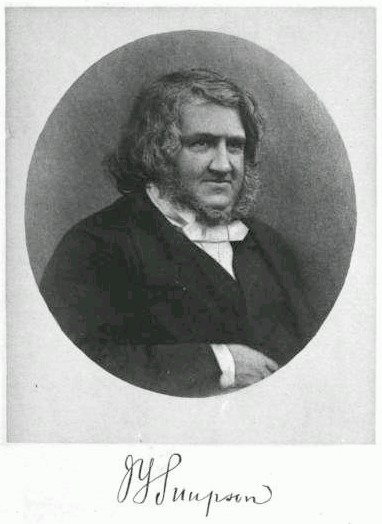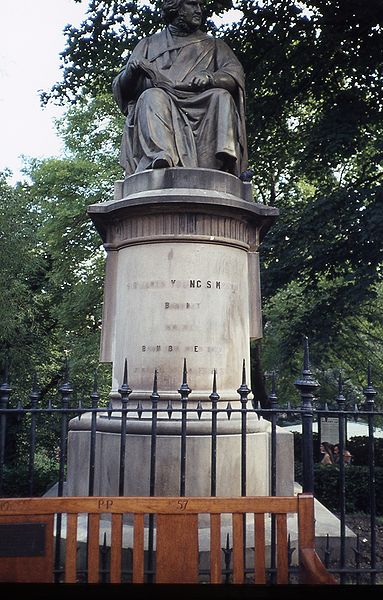<Back to Index>
- Physician James Young Simpson, 1811
- Architect Charles Rennie Mackintosh, 1868
- Prime Minister of the United Kingdom Robert Banks Jenkinson, 2nd Earl of Liverpool, 1770
PAGE SPONSOR


Sir James Young Simpson (7 June 1811 – 6 May 1870) was a Scottish doctor and an important figure in the history of medicine. Simpson discovered the anaesthetic properties of chloroform and successfully introduced it for general medical use.
James Simpson was born in Bathgate, West Lothian, the youngest of eight children, Thomas, John, Alexander, David, George (died young), George and a sister Mary. His parents were Mary Jarvey (also known as Jarvie) and David Simpson, a baker in Bathgate. James received his initial education at the local school, but because of his obvious abilities his father and brothers (his mother died when he was 9) together paid for a college education and he entered the University of Edinburgh when he was 14 years old. He became a Licentiate in 1830 before graduating in 1832. He was appointed Professor of Midwifery (which would now be called Obstetrics) at the University of Edinburgh and physician to Queen Victoria.
Simpson's
name at birth was "James Simpson", as recorded at his baptism on 30
June. It is unknown why he formally adopted the middle name "Young".
One theory is that, as a very young professor, he was flaunting his
youth in front of his older peers or alternatively that he was known by
the affectionate nickname of "Young Simpson" and decided to incorporate
it into his name. Simpson
completed his final medical examination at the age of 18 but, as he was
so young, had to wait two years before he got his license to practice
medicine. It was during this period that he became a Freemason, being initiated in a Lodge in his home town of Bathgate. Simpson
developed an interest in obstetrics, and at the age of 28 was appointed
Chair of Midwifery at the University of Edinburgh. He improved the
design of obstetric forceps and, like Semmelweis, fought against the contagion of puerperal sepsis. His most noted contribution was the introduction of anaesthesia to childbirth. A free thinker by
most accounts, Simpson's intellectual interests ranged from archaeology
to an almost taboo subject at the time: hermaphroditism. He was a very
early advocate of the use of midwives in the hospital environment. Many
prominent women also consulted him for their gynaecological problems. It
was his achievements and wide ranging interests that led to his town
house at 52 Queen Street, Edinburgh being a gathering point for many
members of society, especially intellectual free thinkers. His impish
sense of humour got the better of him on at least one of these
occasions when he sat a Southern U.S. slave owner next to a freed slave
at the dinner table. Since this town house was fairly busy at times,
Simpson preferred to keep his wife and children at their country house
near Bathgate. He was elected a member of the Royal Swedish Academy of Sciences in 1863. Sir Humphry Davy used the first anaesthetic in 1799, nitrous oxide laughing gas. R. Liston ether was dismissed as an anaesthetic as it irritated the lungs of the patients. In 1847 Simpson discovered the properties of chloroform during
an experiment with friends in which he learnt that it could be used to
put one to sleep. Dr Simpson and two of his friends, Drs Keith and
Duncan used to sit every evening in Dr Simpson's dining room to try new
chemicals to see if they had any anaesthetic effect. On 4th November,
1847 they decided to try a ponderous material named chloroform that
they had previously ignored. On inhaling the chemical they found that a
general mood of cheer and humour had set in. But suddenly all of them
collapsed only to regain consciousness the next morning. Simpson knew,
as soon as he woke up, that he had found something that could be used
as an anaesthetic. They soon had Miss Petrie, Simpson's niece, try it.
She fell asleep soon after inhaling it while singing the words, "I am
an angel!". It
was very much up to chance that Simpson survived the chloroform dosage
he administered to himself. If he had inhaled too much, subsequently
passing away from an overdose, chloroform would have been seen as a
dangerous substance. However, if Simpson had inhaled slightly less it
would not have put him to sleep. It was his willingness to explore the
possibilities of the substance that established his career as a pioneer
in the field of medicine. Simpson
first used his anaesthetic to help ease the pain during childbirth.
Some may have opposed this practice, interpreting it as an act against
nature or the will of God. However, A.D. Farr's study has shown that
this was a distinctly minority view. Wider acceptance of Simpson's efforts came when Queen Victoria used chloroform during the delivery of Prince Leopold in 1853. The anaesthetist was John Snow. Full
recognition of Simpson's work followed quickly. He was the first man to
be knighted by the Scottish Court of the Lord Lyon for services to
medicine. "Victo Dolore" (pain conquered) is the inscription of his coat of arms.
Simpson
died at his home in Edinburgh at the age of fifty-eight. A burial spot
in Westminster Abbey was offered to his family, but they declined and
instead buried him closer to home in Warriston Cemetery, Edinburgh. However, a memorial bust can be found in a niche at Westminster Abbey in
London. On the day of Simpson's funeral, a Scottish holiday was
declared, including the banks and stock markets, with over 100,000
citizens lining the funeral cortege on its way to the cemetery, while
over 1,700 colleagues and business leaders took part in the procession
itself.